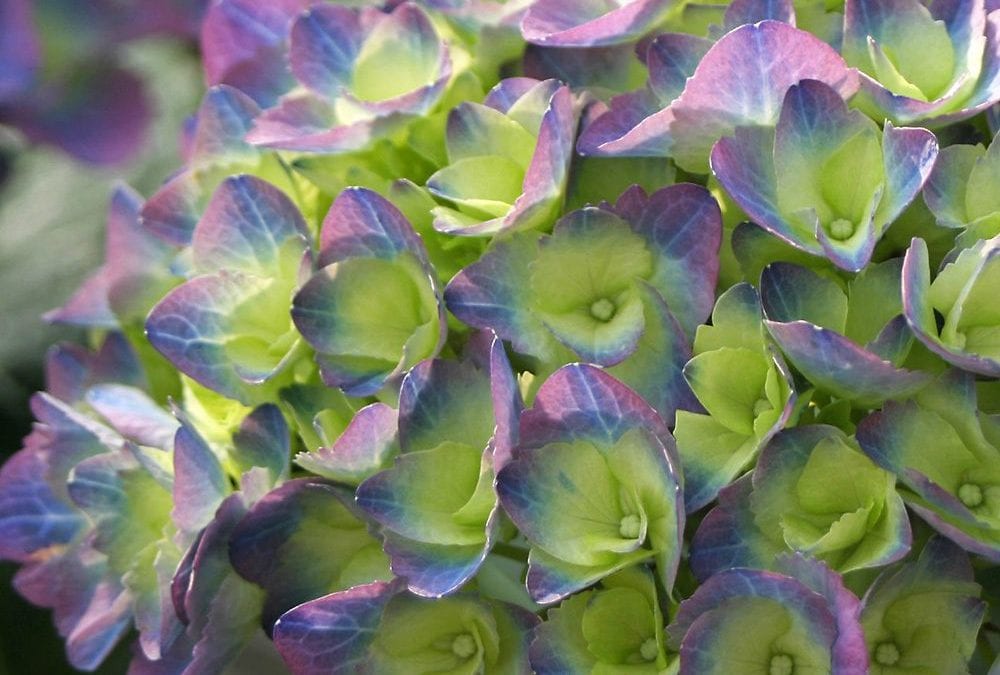Time marches ever forward in our gardens. And even though Spring was delayed, I am relishing every minute of this year’s peony and iris combo. In fact, the compression of the season has led to all sorts of interesting combinations. For instance, you might think that forsythia and PJM rhododendron blooming next to one another would be garish. It was surprisingly pleasing. But now it’s time to look at what summer has to offer us. I for one, am counting on a fabulous display from that summertime staple, the hydrangea. There is a variety for every garden, whether your boat is floated by the big, blousy mopheads or the delicate lacecaps.
The Hydrangea family consists of many marvelous flowering shrubs. They provide show-stopping flowers at a time when other shrubs are looking a bit jaded. Hydrangeas are versatile plants, with a species for any location. And why are gardeners so fascinated by hydrangeas? Prized for their billowy flower heads and mid to late summer bloom, they lend a sparkling note to the landscape. As a bonus, in early fall the flowers often age to softer hues, persisting into the winter and adding interest to the sleeping garden.
The most common complaint that I hear about Hydrangea is the reputed difficulty in getting them to bloom. Non-flowering is almost always caused by one of two factors-improper siting and improper pruning. So let’s take a look at the different species and consider in what places they will thrive and how to best assure flower production.
Smooth Hydrangea, or H arborescens, is the easiest of the group. Since this species will bloom on new growth, it can be pruned to the ground in late fall or very early spring. ‘Annabelle’ is a popular variety with huge, creamy white flowers, but the newer ‘Incrediball’ has sturdier stems that resist flopping. If your garden is pretty full, and honestly whose isn’t, take a look at ‘Seaside Bar Harbor’. Smooth types will flower with very little sun and are soil adaptable.
Bigleaf Hydrangea, H macrophylla, used to be trickier. ‘Nikko Blue’, a popular variety in the 1990’s, flowered on old growth and the flower buds needed the protection of mulch from winter wind and cold temperatures. The ‘Endless Summer’ series, introduced in 2004 turned the world upside-down for many northern gardeners as these flower buds are produced on both new and old growth, ensuring blossoms every year. There are even more choices now. Besides the four ES hydrangeas, check out the Cityline series like ‘Paris’ and ‘Rio’. Bigleafs perform best with 3-4 hours of morning sun and even moisture. Wait until spring to prune out dead stems. This will encourage new growth to come from the roots.
Panicled Hydrangea, H paniculata, is the only species that will thrive in full sun. The flower heads are an elongated cone shape, and creamy white in color. As the blossoms mature, they often change in hue to a deep pink. ‘Vanilla Strawberry’ has an especially vivid color change. I also like the diminutive size of ‘Bobo’. Plant Panicled Hydrangeas in sunny, open areas with good drainage and be sure to give them enough room as some varieties will get quite large. You can prune back to the first pair of buds below a last year’s flower head.
The requirements of Oakleaf Hydrangea, H quercifolia, are similar to the older Bigleaf varieties. Winter protection is a must if you want flowers, but the plant’s large size can make this difficult. I’ve found that the huge, lobed leaves and stunning burgundy fall color make the flowers an added bonus, so I don’t protect my Oakleafs. ‘Alice’ has a lovely elongated flower head and ‘Ruby Slippers’ is a more compact plant. This group of Hydrangeas prefer several hours of morning sun and is less prone to wilting in the heat. It’s best to be patient with these as they are slow to wake up in the spring. Once leaves begin to emerge on the stems, prune out any brittle branches and tips.
Finally, let’s answer the second most asked question about Hydrangea: How do you make the flowers blue? Some, but not all, Bigleaf varieties will have flowers that vary in color from pink to blue. This color change is effected by the amount of iron in the soil and to get blue flowers in our area requires a change in the soil’s pH level. Acidic fertilizers applied to the plant foliage may have an immediate benefit, but the change will be fleeting. To achieve long term results, apply granulated garden sulfur to the soil around your Bigleaf Hydrangea every spring and every fall.

